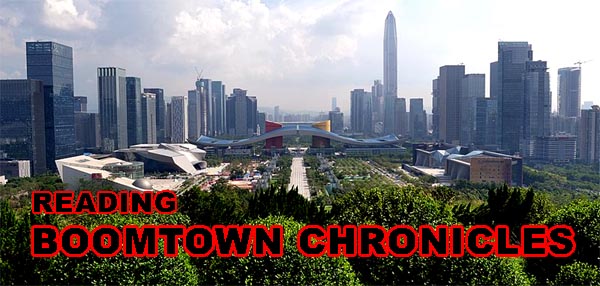 |
| Shenzhen, the Boomtown (Wikipedia) |
Note: Between Lesson #01-128 and #01-207, I wrote 72 lessons explaining expressions in articles published in the Shenzhen Daily. Read more about "Reading Boomtown Chronicles."
Get Ready: Do you know what the power source is in your area? Is it hydroelectric, nuclear, fossil-based (coal, oil, gas), renewable (wind, solar), or some combination of these?
Boomtown Chronicles Part XVI - published Monday, October 13, 2008
- Title: "Plant started era of nuclear power."
nuclear: related to atomic energy. The power generated by a nuclear power plant comes from the splitting of the nucleus of an atom (thus "atomic power"). "Nucleus" means "center," and is used in many ways. For example, a few people meeting in a park can become the "nucleus" for a large English Corner.
The word "nuclear," by the way, is pronounced "NEW-klee-er." U.S. president Gearoge W. Bush was often criticized for pronouncing it "NEWK-ya-ler."
- "nuclear installations"
installation: a dedicated complex of buildings. An installation can be anything that has been installed (such as some equipment, or even a work of art). But we also use the term for things like "military installations." Here, we may be talking about both: a "nuclear plant" has equipment installed, and features a complex of support buildings.
- "15 billion kwh"
kwh: kilowatt hours. This is an amount of energy equal to the work done by one kilowatt in one hour. A kilowatt is 1000 watts. So imagine the amount of energy used by ten light bulbs rated at 100 watts burning for one hour; that's one "kwh."
- "hydroelectric resources"
hydroelectric: power generated by flowing water. Often, it turns some kind of wheel or turbine, and electric power is generated. (Hydro-, of course, means "water.")
In the early days of the Industrial Revolution, before electricity was in common use, factories would often be located near waterfalls or rivers, which would turn a waterwheel to power machines. Later, the idea of this mechanical power was applied to the generation of electricity, which could then be used in areas remote from the water source.
--------
Read more: https://en.wikipedia.org/wiki/Shenzhen
Practice: Choose the correct term to fill in the blank in the sentence below:
- hydroelectric
- installation
- kwh
- nuclear
- We went to visit an ________ of artworks created by children in refugee camps.
- ________ power is cleaner than power from fossil fuels.
- ________ power is cleaner than hydroelectric, but some people still fear the danger of accidents.
- The average price of electricity in the U.S. is around 13.31 cents per ________.
Answers are in the first comment below.
Submitted to the Shenzhen Daily for October 13, 2008


Answers to the Practice: 1. b; 2. a; 3. d; 4. c
ReplyDelete